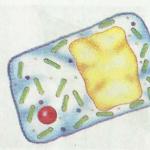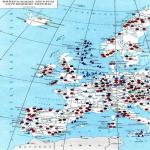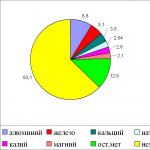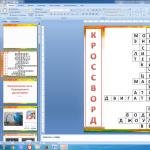The purpose of the lesson: form the concept that induced emf can occur either in a stationary conductor placed in a changing magnetic field, or in a moving conductor located in a constant magnetic field; the law of electromagnetic induction is valid in both cases, but the origin of the emf is different.
During the classes
Checking homework using the method of frontal questioning and problem solving
1. What quantity changes proportionally to the rate of change of magnetic flux?
2. Work, what forces does the induced emf create?
3. Formulate and write down the formula for the law of electromagnetic induction.
4. The law of electromagnetic induction has a minus sign. Why?
5. What is the induced emf in a closed turn of wire, the resistance of which is 0.02 Ohm, and the induced current is 5 A.
Solution. Ii = ξi /R; ξi= Ii·R; ξi= 5 0.02= 0.1 V
Learning new material
Let us consider how induced emf occurs in stationary conductor, located in an alternating magnetic field. The easiest way to understand this is
Using the example of a transformer.
One coil is closed to the alternating current network; if the second coil is closed, then a current arises in it. The electrons in the wires of the secondary winding will begin to move. What forces move free electrons? A magnetic field cannot do this, since it only acts on moving electric charges.
Free electrons move under the influence of an electric field that was created by an alternating magnetic field.
Thus, we come to the concept of a new fundamental property of fields: changing over time, the magnetic field generates an electric field. This conclusion was made by J. Maxwell.
Thus, the main thing in the phenomenon of electromagnetic induction is the creation of an electric field by a magnetic field. This field sets free charges in motion.
The structure of this field is different from that of the electrostatic one. It is not associated with electrical charges. Tension lines do not start at positive charges and do not end at negative charges. Such lines have no beginning or end - they are closed lines similar to magnetic field induction lines. This is a vortex electric field.
The induced emf in a stationary conductor placed in an alternating magnetic field is equal to the work of the vortex electric field moving charges along this conductor.
Toki Foucault (French physicist)
The benefits and harms of induction currents in massive conductors.
Where are ferrites used? Why don't eddy currents arise in them?
Reinforcing the material learned
– Explain the nature of external forces acting in stationary conductors.
– Difference between electrostatic and vortex electric fields.
– Pros and cons of Foucault currents.
– Why don’t eddy currents occur in ferrite cores?
– Calculate the induced emf in the conductor circuit if the magnetic flux changed by 0.06 Wb in 0.3 s.
Solution. ξi= – ΔФ/Δt; ξi= – 0.06/0.3 = 0.2 V
Let's summarize the lesson
Homework: § 12, rep. § 11, exercise 2 No. 5, 6.
- Objective of the lesson: to formulate the quantitative law of electromagnetic induction; Students must understand what magnetic induction emf is and what magnetic flux is. Progress of the lesson Checking homework...
- Purpose of the lesson: to find out what causes the induced emf in moving conductors placed in a constant magnetic field; lead students to the conclusion that a force acts on charges...
- Purpose of the lesson: to form an idea of the magnetic field as a type of matter; expand students' knowledge about magnetic interactions. Lesson progress 1. Analysis of the test 2. Learning new...
- The purpose of the lesson: to form in students an idea of the electric and magnetic field as a single whole - the electromagnetic field. Lesson progress Checking homework using testing...
- Purpose of the lesson: to find out how the discovery of electromagnetic induction occurred; form the concept of electromagnetic induction, the significance of Faraday’s discovery for modern electrical engineering. Lesson progress 1. Analysis of the test...
- Purpose of the lesson: to form the idea that a change in current strength in a conductor creates a vortex wave that can either accelerate or slow down moving electrons. During the classes...
- Objective of the lesson: introduce the concept of electromotive force; obtain Ohm's law for a closed circuit; create in students an idea of the difference between emf, voltage and potential difference. Progress...
- Purpose of the lesson: to introduce students to the history of the struggle between the concepts of close action and action at a distance; with the shortcomings of theories, introduce the concept of electric field strength, develop the ability to depict electrical...
- Purpose of the lesson: based on the model of a metal conductor, study the phenomenon of electrostatic induction; find out the behavior of dielectrics in an electrostatic field; introduce the concept of dielectric constant. Lesson progress Checking homework...
- Purpose of the lesson: to form students’ understanding of electric current; consider the conditions necessary for the existence of electric current. Lesson progress 1. Analysis of the test 2. Study of new material...
- The purpose of the lesson: to test students’ knowledge on the topic studied, to improve their skills in solving problems of various types. Progress of the lesson Checking homework Students' answers based on what they prepared at home...
- Purpose of the lesson: to consider the structure and principle of operation of transformers; provide evidence that electric current would never have had such widespread use if at one time...
- The purpose of the lesson: to continue to develop in students the unity of oscillatory processes of various natures. Lesson progress 1. Analysis of the test. 2. Studying new material When studying electromagnetic oscillations...
- Objective of the lesson: to form the idea that magnetic fields are formed not only by electric current, but also by permanent magnets; consider the scope of application of permanent magnets. Our planet...
- The purpose of the lesson: to form an idea of the energy possessed by an electric current in a conductor and the energy of the magnetic field created by the current. Lesson progress Checking homework using testing...
Vevcherenkova A.N. physics teacher, Tobolsk
Open lesson on the topic "Electric field. Conductors and dielectrics"
Class: 8A
Date: 12/09/16
The purpose of the lesson : To form students’ ideas about the electric field and its properties, conductors and dielectrics. Practice the concepts: electrification of bodies, electric charge, interaction of charges, two types of electric charges.
Lesson type : combined
Lesson form: peer learning lesson
Developed skills : observe, compare, analyze
Lesson Plan :
Organizing time.
The teacher greets the students. Marks those present.
Work at the board. Repetition
In the last lesson, we studied the types of charges and the rules for the interaction of these charges. I offer you the following task: the interactions of charges are drawn on the board. It is necessary to determine the “sign” of the charge of the ball with a question mark.
Teacher :
So, guys, we have repeated two important properties of electrified bodies: like charges repel, and unlike charges attract.
Now let's remember what kind of body is called electrified or what is static electricity?
Today in class we continue to study the topic of electrification, and in order to find out the topic of today's lesson, we need to check our homework. You have been given a crossword puzzle for home. Let's check what you got.
Checking homework. Setting the goal and objectives of the lesson.

Questions:
What do substances consist of?
Kinetic, internal, potential, what is it?
What value was measured in versts per hour in Rus'??
Which element is number three in the periodic table??
Name a device for measuring temperature.
Name the thermal process accompanied by intense evaporation of liquid throughout the entire volume.
Name the unit in which time is measured.
Name the creator of the temperature scale.
Measure of inertia and gravity.
What is the name of the thermal process in which a transition from a gaseous state to a liquid occurs??
What are molecules made of?
ICE stands for... internal combustion.
What is the reverse crystallization process called??
Name the first chemical element in D.I. Mendeleev’s table.
Name the unit in which the amount of heat is measured.
Name one example of air convection on a huge scale?
Keyword ELECTRIC FIELD
These keywords will be the topic of our lesson today. (write down the topic of the lesson and the date in the notebook)
Target: Today in class we will learn what an electric field is; learn the difference between conductors and dielectrics; Let us give examples of substances that are conductors and non-conductors of electricity.
So we know thatCharged bodies act on each other, although at first glance there is no intermediary between them . Since electrical interaction occurs not only in air, but also in vacuum.
English physicists Michael Faraday and James Maxwell studied the interaction of electric charges; these scientists you see on the screen.
The conclusions made by these great scientists are that there is an environment around charged bodies, thanks to whichelectrical interaction . The space surrounding one charge interacts with the space surrounding another charge and vice versa.The mediator in this interaction will be the electric field.
To learn more about this special type of matter, what is called conductors and dielectrics, I have prepared tasks for you; you will complete these tasks in mini groups. 10 minutes are allotted to complete the task, after which each group presents its answers to the questions.
Independent work using cards on the topic “Electric field. Conductors and non-conductors of electricity”
GroupIquestions:
What devices check the presence of charge?______________________________
What is an electric field?__________________________________________________________
_____
What bodies are called conductors?_____________________________________________
_______________________________________________________________________
_______________________________________________________________________
Give examples of conductors:__________________________________________
_______________________________________________________________________
GroupIIquestions:
What are dielectrics?________________________________________________
____________________________________________________________________
Give examples of dielectrics: _____________________________________________
____________________________________________________________________
What are bodies made of dielectrics called? _____________________
____________________________________________________________________
GroupIIIquestions: (Use the Internet to answer questions)
What professions use knowledge about the electric field, conductors and dielectrics? ___________________________________________________________
________________________________________________________________________
________________________________________________________________________
Which universities teach these professions? ___________________________________
_________________________________________________________________________
Learning new material
When answering questions, the rest of the groups write down the main points in their notebooks.
Our senses do not perceive the electric field (for example, we cannot touch it). But it surrounds any charged body.
The main property of the electric field is its ability to act on electric charges with some force.
The force with which an electric field acts on an electric charge introduced into it is called electric force.
Experience: plume + ebonite stick with fur.
Let's conduct an experiment: Let's charge an ebonite stick by rubbing it against the fur and bring it to the plume.
What's going on with the sultan? (the petals of the plume begin to be attracted to the stick)
Why is the plume attracted to the ebonite stick? (since a positive charge is distributed on the petals, the stick itself has a negative charge, and opposite charges attract)
What can we say about the action of the electric field near the plume and at a distance from it?
conclusion : Near charged bodies the effect of the field is stronger, and as you move away from them the field weakens.
The ribbons of plumes are located along the electric field lines - that is, along the lines, the tangents to which at each point of the field coincide with the vector of force acting from the field on the charge placed at this point.
Fixing the material.
How does the space surrounding a charged body differ from the space surrounding an uncharged body?(The existence of an electric field)
How can an electric field be detected?(When introducing an electric charge)
If you touch a charged metal ball with your finger, it loses almost all its charge. Why?(Since the person is a good guide)
Is it enough to simply touch the electrometer with a charged ebonite stick to cause the needle to deflect?(Yes)
Homework:Read §26,27,31.
Task to choose from:
Exercise 19;
Experimental task on page 78 (describe the result in your notebook);
ESSAY on the topic “Life without an electric field”;
Bibliography:
1. Peryshkin A.V. Physics. 8th grade: textbook. for general education institutions. – 8th ed., add. – M.: Bustard, 2006. – 191.
Subject. Law of Electromagnetic Induction
Purpose of the lesson: to familiarize students with the law of electromagnetic induction.
Lesson type: lesson on learning new material.
LESSON PLAN
Knowledge control |
1. Magnetic induction flux. 2. The phenomenon of electromagnetic induction. 3. Lenz's rule. |
|
Demonstrations |
1. Dependence of induced emf on the rate of change of magnetic flux. 2. Fragments of the video film “The phenomenon of electromagnetic induction.” |
|
Learning new material |
1. The law of electromagnetic induction. 2. Vortex electric field. 3. Induction emf in moving conductors. |
|
Reinforcing the material learned |
1. Qualitative questions. 2. Learning to solve problems. |
LEARNING NEW MATERIAL
Where do the extraneous forces that act on the charges in the circuit come from? In the case of a conductor stationary relative to the observer, the cause of the appearance of extraneous forces is an alternating magnetic field. The fact is that an alternating magnetic field generates an electric field in the surrounding space - it is this field that acts on free charged particles in the conductor. But the generation of an electric field by a magnetic field occurs even where there is no leading circuit and no electric current arises. As we see, a magnetic field can not only transmit magnetic interactions, but also cause the appearance of another form of matter - an electric field.
However, the electric field generated by an alternating magnetic field is significantly different from the field created by charged particles.
The electric field created by an alternating magnetic field is vortex, that is, its lines of force are closed.
The vortex electric field has some features:
1) the field manifests itself through a force effect on charged particles, therefore the main characteristic of the vortex electric field is intensity;
2) unlike the electrostatic field, the intensity lines of the vortex electric field are closed. The direction of these lines can be determined using, for example, the left hand, as shown in the figure:

3) unlike the electrostatic field, the work of the vortex electric field along a closed trajectory is not zero (the vortex electric field is non-potential).
Let us consider a conductor of length l moving translationally in a uniform magnetic field with induction at a speed directed at an angle to the lines of magnetic induction of the field.

Electrons moving along with a conductor in a magnetic field are acted upon by the Lorentz force directed along the conductor. Its module
![]()
where q 0 is the charge of a free charged particle. Under the influence of this force, a separation of charges occurs - free charged particles will move to one end of the conductor, and at the other end there will be a shortage of them, that is, they will exceed the charge of the opposite sign. Therefore, in this case the external force is the Lorentz force. The separation of charges will lead to the appearance of an electric field, which will prevent further separation of charges. This process will stop when the Lorentz force and the force = q 0 balance each other. Consequently, inside the conductor the electric field strength is E = B sin, and the potential difference at the ends of the conductor is U = El = B lsin. Since we are considering an open circle, the potential difference at the ends of the conductor is equal to the induced emf in this conductor. Thus,
![]()
If such a conductor is short-circuited, then an electric current will pass in a circle. Thus, a conductor moving in a magnetic field can be considered as a kind of current source characterized by induced emf.
QUESTIONS TO STUDENTS DURING PRESENTATION OF NEW MATERIAL
First level
1. Why does an induced current arise in stationary conductors located in an alternating magnetic field?
2. What is the reason for the occurrence of induced current when a conductor moves in a constant magnetic field?
3. What are the features of the vortex electric field?
Second level
1. What is the nature of the external forces that cause the appearance of induced current in a stationary conductor?
2. Why is the law of electromagnetic induction formulated for EMF, and not for current?
3. What is the nature of the induced emf in a conductor moving in a magnetic field?
CONSTRUCTION OF LEARNED MATERIAL
) . Qualitative questions
1. Why do fuses sometimes blow from a lightning strike even when the appliance is unplugged?
2. Why is it better to take a closed conductor in the form of a coil, and not in the form of a straight wire, to detect an induction current?
) . Learning to solve problems
1. Using flexible wires, a straight conductor 60 cm long is connected to a direct current source with an emf of 12 V and an internal resistance of 0.5 Ohm. The conductor moves in a uniform magnetic field with an induction of 1.6 Tesla at a speed of 12.5 m/s perpendicular to the lines of magnetic induction. Determine the current strength in the conductor if the resistance of the external circuit is 2.5 Ohms.
Slide 2
Checking homework
Report about E.H. Lenze (student prepared)
Slide 3
Physical dictation:
1. What is the phenomenon of electromagnetic induction? 2. Under what condition does current occur in a closed conducting circuit? 3.-4 Continue the phrases: 3. The magnetic flux through a surface of area S is the quantity... 4. According to Lenz’s rule, the induced current arising in a closed circuit...
Slide 4
5. Formulate the Law of Electromagnetic Induction. 6. 7. 8. S N V The conductor moves across the magnetic field lines from right to left. Determine the direction of the induction current. V Determine the direction of the magnetic induction vector and the polarity of the permanent magnet. S Determine the polarity of the induction voltage.
Slide 5
Vortex electric field.
When does induced emf occur? An induced emf occurs either in a stationary conductor placed in a field that changes with time, or in a conductor moving in a magnetic field, which may not change with time.
Slide 6
Slide 7
MAXWELL James Clerk (1831-79), English physicist, creator of classical electrodynamics, one of the founders of statistical physics, organizer and first director (from 1871) of the Cavendish Laboratory. Developing the ideas of M. Faraday, he created the theory of the electromagnetic field (Maxwell's equations); introduced the concept of displacement current, predicted the existence of electromagnetic waves, and put forward the idea of the electromagnetic nature of light. Established a statistical distribution named after him. He studied the viscosity, diffusion and thermal conductivity of gases. Showed that the rings of Saturn consist of individual bodies. Works on color vision and colorimetry (Maxwell disk), optics (Maxwell effect), elasticity theory (Maxwell's theorem, Maxwell-Cremona diagram), thermodynamics, history of physics, etc.
Slide 8
Changing over time, the magnetic field generates an electric field
Slide 9
Slide 10
The work of a vortex electric field when moving a single positive charge along a closed stationary conductor is numerically equal to the induced emf in this conductor.
Slide 11
Slide 12
What is the difference between a vortex electric field and a potential one?
Slide 13
Jean Bernard Leon Foucault September 18, 1819, Paris - February 11, 1868, - French physicist and astronomer, member of the Paris Academy of Sciences Foucault Currents Application of induction furnaces In many cases, Foucault currents are undesirable, so special measures have to be taken to reduce them. In particular, these currents cause heating of the ferromagnetic cores of transformers and metal parts of electrical machines. To reduce losses of electrical energy due to the occurrence of eddy currents, transformer cores are made not from a solid piece of ferromagnet, but from individual metal plates isolated from each other by a dielectric layer.




